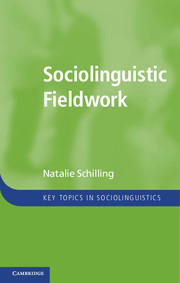2 - Designing the study
Published online by Cambridge University Press: 05 April 2013
Summary
As with any project, completing a successful sociolinguistic research project involves a good deal of pre-planning. Fieldwork is time-consuming, emotionally demanding, and often expensive, and there is nothing worse than spending time and energy in the field only to return home realizing that you should have delimited your population differently, obtained data from different groups or individuals, or perhaps more or fewer speakers, or obtained better quality data, whether in terms of recording quality or in terms of what people said or how they said it. I have taught courses in sociolinguistic field methods and supervised students’ sociolinguistic research projects for a number of years, and I cannot count how many times students have included in their field reports the phrase, “If only I had . . .”
In this chapter, we take the first steps toward eliminating the “if onlys” by stressing the importance of carefully selecting one’s community of study, choosing which speakers to study from within that community, and appropriately categorizing the selected speakers. We also discuss the extra care that must go into planning a re-study of a community previously subjected to sociolinguistic study, for the purposes of obtaining data on language change in real time. While seemingly a re-study would involve a simple replication of previous methods, in actuality replication is by no means “simple”; indeed, exact replication is not really even possible, since even if one manages to record all the same speakers (or the same groupings of speakers, including age, gender, ethnic, and social class groups), using the same interview questionnaire or other survey instrument, the same recording locations, etc., the data-gathering situation will necessarily be different, since the times have changed, and the interviewer and speakers are either different people who were not a part of the original study, or they have aged and changed; hence interviewer and speakers will necessarily interrelate in different ways than in the original study. Obtaining good quality language data are the subjects of Chapters 3 and 4, while good recordings – and record-keeping – are discussed in Chapter 6.
- Type
- Chapter
- Information
- Sociolinguistic Fieldwork , pp. 17 - 65Publisher: Cambridge University PressPrint publication year: 2013



